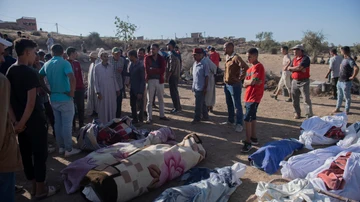Al Haouz province is the most affected by the morocco earthquake, an earthquake of magnitude 7 on the Richter scale that has left more than 2,100 dead and as many injured, according to the latest official report. Only in this area, part of the Marrakech-Safi region, have so far been recorded more than 1,350 dead. The big problem of this region is isolation: many of the Affected areas are remote villages and townswhich have been completely isolated due to the collapse of the roads, which hinders access to medical care and rescue teams.
This is the case, for example, of Imi N’Talawhere the Spanish Firefighters United Without Borders (BUSF) managed to reach this Monday after “eight hours on the road” and where they hope to find some survivors among the rubble. Or the one of Talat N’Yaaqoub, region to which the Rapid Intervention Team of the Community of Madrid (ERICAM) has traveled. It is also the case of Tafeghaghte, another remote village where virtually no residents have been spared the effects of the tremor. “Half of the town is dead; the other half is in the hospital”: one of the survivors of this small municipality of about 400 inhabitants, located about 60 kilometers south of Marrakech, tells the BBC.
Virtually all bricks and stones that built the traditional houses of Tafeghaghte They are lying on the ground, after having been unable to support the homes of the inhabitants of this small village. Ninety of the 200 inhabitants have died, and many others are still missing. “They had no chance to escape, they had no time to save themselves,” laments Hassan, a survivor who managed to escape by climbing through the rubble of the houses. Beneath them is your uncle’s body, but there is no hope of recovering him alive: no one has machinery to lift the stones and roads are blocked, closing access to rescue teams.

Bodies recovered by the Army in Tafeghaghte, a village in the Moroccan High Atlas, one of the areas most affected by the earthquake | EFE/EPA/Jalal Morchidi
Shortly before the ground began to shake, a resident of Tafeghaghte, Hamid ben Henna, asked his young son to bring a knife to the table where the family had dinner to cut melon. The little one, Marouane, explained what he needed to buy to start the school year. “That’s when it happened,” Ben Henna told Reuters. The room began to shake, the lights went out and the house began to fall apart. Ben Henna and his other son, Mouad, managed to get outside before the house collapsed; They helped the wife, Amina, and the young daughter, Meryem, but little Marouane could not leave the house. The 8-year-old boy was buried under the rubble. They did not manage to recover his body until the next day, after Ben Henna’s brothers arrived by car from Casablanca to help them clear the rubble. Ben Henna’s family lost a son and all of his belongings.
In Tafeghaghte only one house seems to have remained standing.
In this small village, Abdou Rahman has lost his wife and three children. “Our house was up there“, he explains to the BBC, pointing to a part of the municipality that, like the rest, is covered in rubble. Rahman was working at a gas station three kilometers from his house when the earthquake occurred; he says he ran home , shouting the name of his children, but never getting a response. They buried them the next day. “When we found them they were all huddled together. The three children were sleeping. They sank with the earthquake,” he explains.
Source: Lasexta
Ricardo is a renowned author and journalist, known for his exceptional writing on top-news stories. He currently works as a writer at the 247 News Agency, where he is known for his ability to deliver breaking news and insightful analysis on the most pressing issues of the day.












